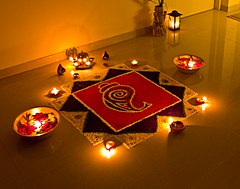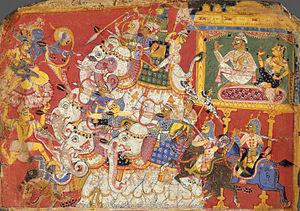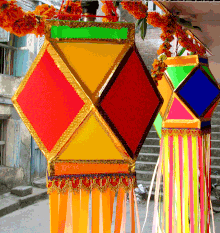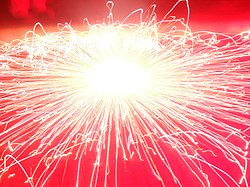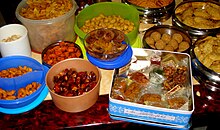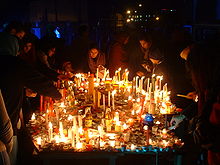Diwali
Dates
- The return of Rama after 14 years of Vanvas (exile). To welcome his return,diyas (ghee lamps) are lit in total of 14.
- The killing of Narakasura: Celebrated as Naraka Chaturdashi, one day before Diwali, it commemorates the killing of the evil demon Narakasura, who wreaked havoc. In different versions, either Krishna or Krishna's wifeSatyabhama killed Narakasura during the Dwapara yuga.
- Govatsa Dwadashi or Vasu Baras (27 Ashvin or 12 Krishna Paksha Ashvin): Gomeans cow and vatsa means calf. Dwadashi or Baras means the 12th day. On this day the cow and calf are worshiped. The story associated with this day is that of KingPrithu, son of the tyrant King Vena. Due to the ill rule of Vena, there was a terrible famine and earth stopped being fruitful. Prithu chased the earth, who is usually represented as cow, and ‘milked’ her, meaning that he brought prosperity to the land.
- Dhanatrayodashi or Dhan teras or Dhanwantari Triodasi (28 Ashvin or 13 Krishna Paksha Ashvin): Dhana means wealth and Trayodashi means 13th day. This day falls on the 13th day of the second half of the lunar month. It is considered an auspicious day for buying utensils and gold, hence the name ‘Dhana’. This day is regarded as the Jayanti (Birth Anniversary) of God Dhanvantari, the Physician of Gods, who came out during Samudra manthan, the churning of the great ocean by the gods and the demons.
- Naraka Chaturdashi (29 Ashvin or 14 Krishna Paksha Ashvin): Chaturdashi is the 14th day This was the day on which the demon Narakasura was killed by Krishna – an incarnation of Vishnu. It signifies the victory of good over evil and light over darkness (Gujarati: Kali Chaudas, Rajasthan : Roop Chaudas). In southern India, this is the actual day of festivities. Hindus wake up before dawn, have a fragrant oil bath and dress in new clothes. They light small lamps all around the house and draw elaborate kolams /rangolis outside their homes. They perform a special puja with offerings to Krishna or Vishnu, as he liberated the world from the demon Narakasura on this day. It is believed that taking a bath before sunrise, when the stars are still visible in the sky is equivalent to taking a bath in the holy Ganges. After the puja, children burst firecrackers heralding the defeat of the demon. As this is a day of rejoicing, many will have very elaborate breakfasts and lunches and meet family and friends.
- Lakshmi Puja (30 Ashvin or 15 Krishna Paksha Ashvin): Lakshmi Puja marks the most important day of Diwali celebrations in North India. Hindu homes worship Lakshmi, the goddess of wealth, and Ganesh, the God of auspicious beginnings also known as the remover of obastacles, and then light deeyas (little clay pots) in the streets and homes to welcome prosperity and well-being.
- Bali Pratipada and Govardhan Puja (1 Kartika or 1 Shukla Paksha Kartika) : In North India, this day is celebrated as Govardhan Puja, also called Annakoot, and is celebrated as the day Krishna – an incarnation of god Vishnu – defeated Indra and by the lifting of Govardhana hill to save his kinsmen and cattle from rain and floods. For Annakoot, large quantities of food are decorated symbolising the Govardhan hill lifted by Krishna. In Maharashtra, Tamil Nadu and Karnataka, it is celebrated as Bali-Pratipada or Bali Padyami. The day commemorates the victory of Vishnu in his dwarf form Vamana over the demon-king Bali, who was pushed into the patala. In Maharashtra, it is called Padava or Nava Diwas (new day). Men present gifts to their wives on this day. It is celebrated as the first day of the Vikram Samvat calendar, in Gujarat.
- Yama Dwitiya or Bhaiduj (also Bhayyaduj, Bhaubeej or Bhayitika) (2 Kartika or 2 Shukla Paksha Kartika): on this day, brothers and sisters meet to express love and affection for each other (Gujarati: Bhai Bij, Bengali: Bhai Phota). It is based on a story when Yama, lord of Death, visited his sister Yami (the river Yamuna). Yami welcomed Yama with an Aarti and they had a feast together. Yama gave a gift to Yami while leaving as a token of his appreciation. So, the day is also called 'YAMA DWITIYA'. Brothers visit their sisters’ place on this day and usually have a meal there, and also give gifts to their sisters
Goddess Lakshmi Puja
- Lakshmi: Divine Energy (Shakti) which provides energy to all the above activities.
- Vishnu: Happiness (happiness and satisfaction)
- Kubera: Wealth (generosity; one who shares wealth)
- Indra: Opulence (satisfaction due to wealth)
- Gajendra: Carries the wealth
- Saraswati: Knowledge
Spiritual significance
Significance in other religions
Jainism
Regional New Year celebrations
- The Marwari New Year is celebrated on the day of the festival of Diwali, which is the last day Krishna Paksha of Ashvin month & also last day of the Ashvin month of Hindu calendar.
- The Gujarati New Year is celebrated the day after the festival of Diwali (which occurs in mid-fall – either October or November, depending on the Lunar calendar). The Gujarati New Year is synonymous with sud ekam i.e. first day of Shukla paksha of the Kartikmonth -, which is taken as the first day of the first month of Gujarati lunar calendar. Most other Hindus celebrate the New Year in early spring. Gujarati community all over the world celebrates the New Year after Diwali to mark the beginning of a new fiscal year.
- The Nepal Era New year is celebrated in regions encompassing original Nepal. The new year occurs in the fourth day of Diwali. The calendar was used as an official calendar until the mid 19th century. However, the new year is still celebrated by citizens of original Nepal, the Newars.

